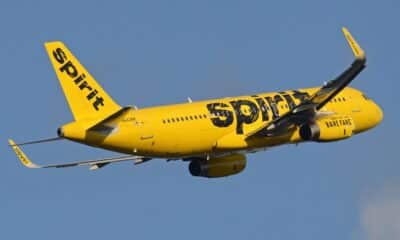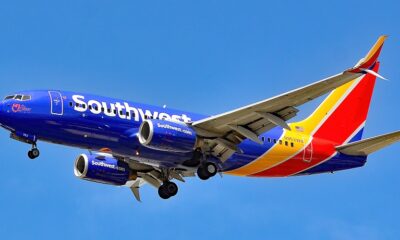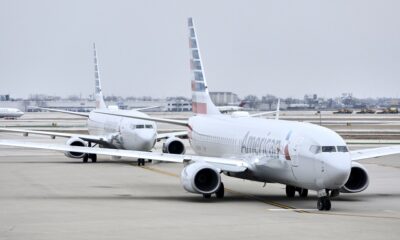Aviation
Top Quality Airline Rating 2018 in United States
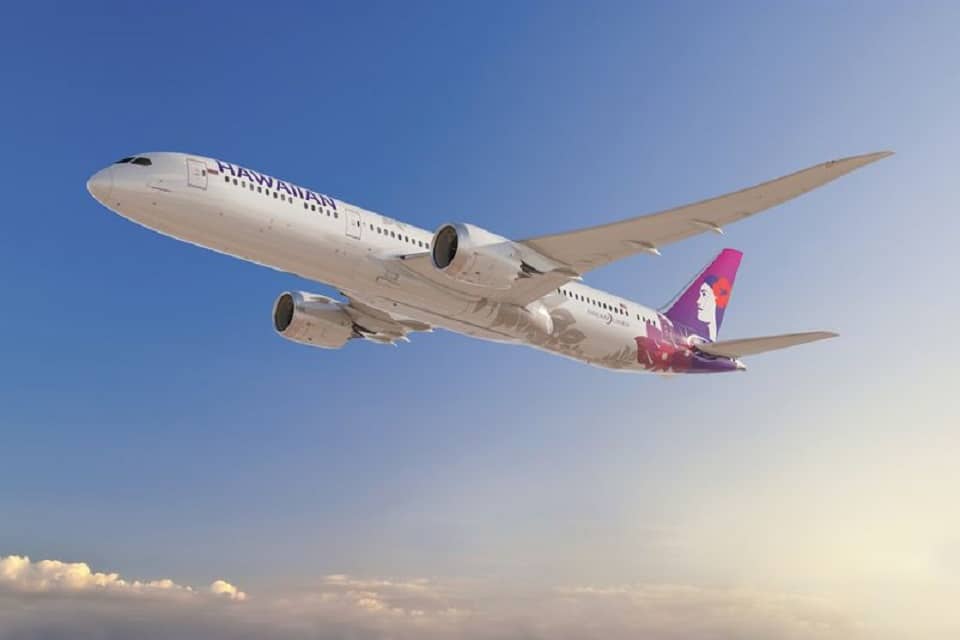
Top Quality Airline Rating 2018 in United States
The Airline Quality Rating industry score for 2017 shows an industry that improved in overall performance quality over the previous year. Nine airlines (American, ExpressJet, Frontier, Hawaiian, JetBlue, SkyWest, Southwest, Spirit and United) showed improvement in AQR scores in 2017.
1. Alaska Airlines
Founded in 1932, Alaska Airlines began on a route between Anchorage and Bristol Bay, Alaska. Shortly thereafter in 1934, a merger took place with Star Air Service, and while the airline changed several times, the name Alaska Airlines prevailed. During the 1940s, charter work including the Berlin Airlift and Operation Magic Carpet, aided thousands. Additional mergers in the late 1960s with Alaska Coastal-Ellis and Cordova Airlines further expanded routes. Alaska Airlines was also involved in the construction of the trans-Alaska Pipeline.
Service has continued to expand. The airline now has routes to the East Coast, Washington D.C., multiple Midwestern towns as well as Hawaii. Alaska Airlines contributes its success to its people, “their caring, their resourcefulness, their integrity, their professionalism, and their spirit.”
2. Delta Air Lines
A legacy carrier today, Delta Air Lines began as a crop-dusting operation, the Huff Daland Dusters, in Macon, Georgia. Passenger operations commenced in 1929, and the company became known as Delta Air Lines in 1934. In 1955, Delta blazed the trail with the implementation of the hub and spoke system for air travel. The company expanded by merging with Northeast Airlines in 1972 and acquiring Pan Am’s trans-Atlantic routes and the Pan Am Shuttle in 1991. Further expansion took place in 2008, as Delta acquired Northwest Airlines.
Today, along with Delta Connection, Delta Air Lines serves 312 communities in 54 countries. Together with members of the SkyTeam alliance, destinations span 648 cities in 123 countries on six continents. Delta’s 80,000 employees maintain and operate a fleet exceeding 800 aircraft.
3. JetBlue
Early in 1999, David Neeleman laid forth his plans for a new airline. By the end of the year, JetBlue (initially known as “New Air”), had secured 75 aircraft and as many slots at JFK. In February 2000, the airline began operations. By the end of the same year, over one million passengers had flown on JetBlue.
In the years that have followed, JetBlue expanded its fleet and route structure. Today, JetBlue operates flights in North, Central and South America. JetBlue currently partners with 40 airlines globally, offering a plethora of destination cities.
4. Hawaiian Airlines
The first scheduled flight of Inter-Island Airways took off in 1929. Continuous growth ensued, and, in 1941, the airline was renamed Hawaiian Airlines in order to prepare for Transpacific flights. The following year, Hawaiian Airlines received the first U.S. Cargo Service Certificate.
Today, Hawaiian Airlines provides service to every major Hawaiian island, as well as destinations in North America, Asia and the South Pacific. Additionally, Hawaiian Airlines holds codeshare agreements with a multitude of airlines worldwide.
5. Southwest Airlines
The vision for Southwest Airlines was sketched out on a cocktail napkin. After many legal hurdles were cleared, Southwest began service in 1971. Passengers responded positively to the airline and its $20 fares. Routes expanded from Texas, reaching the coast in the 1980s. Growth continued in the decades following, with destinations spanning the United States from coast to coast.
Southwest is known for its 737 fleet, low fares, quick turns and corporate culture. Today, the airline serves approximately 100 communities in North America.
6. SkyWest Airlines
SkyWest Airlines commenced operations in 1972 with the purchase of Dixie Airlines. Operations expanded as the airline entered into interline agreements in 1977. In 1986, the airline began to offer stock publicly under the symbol SKYW. The following year, SkyWest became a Delta Connection carrier.
Today, SkyWest Airlines partners with United, Delta, Alaska Airlines and American Airlines. SkyWest flies to hundred of destinations in North America, operating approximately 1,700 flights per day.
7. Virgin America
Virgin America is a relative newcomer airline. Founded in 2007, Virgin America began as low-fare, high-technology company whose mission is “to make flying fun again”. Its fleet consists of Airbus A-320 aircraft.
Headquartered in San Francisco, California, Virgin America offers destinations in the continental United States, Hawaii, and Mexico. The airline employs approximately 3,000.
8. United Airlines
United Airlines is one of the United States’ original legacy carriers. With roots as United Aircraft and Transport Corporation, the company evolved into United Air Lines and was advertised as the “World’s Largest Air Transport System.”
Currently, United serves over 335 cities, of which 127 are international destinations. The route structure is very comprehensive. Nearly 87,500 people are employed by the airline. United is headquartered in Chicago, Illinois.
9. American Airlines
American Airlines began in 1926 with a flight piloted by Charles Lindberg carrying mail from St. Louis, Missouri to Chicago, Illinois. Soon thereafter, founder C.R. Smith was instrumental in bringing the DC-3, a plane that revolutionized aviation, into service. A legacy carrier, American Airlines continued to grow and expand routes over the decades that followed.
In 2013, American Airlines’ AMR Corporation and US Airways Group formed the American Airlines Group. Two years later, American and US Airways began operating as one airline. American Airlines is a member of the oneworld® alliance, which serves more than 1,000 cities in 160 countries.
10. ExpressJet
ExpressJet began operations as Atlantic Southeast Airlines. After acquiring Southeastern Airways in 1983, Atlantic Southeast became the first Delta Connection carrier. In 1996, Continental Airlines renamed Continental Express “ExpressJet” for market distinction. Fifteen years later, the new ExpressJet is formed when Atlantic Southeast and ExpressJet receive single operating certificate status from the Federal Aviation Administration.
Today, ExpressJet operates 1,500 flights per day to over 180 airports as American Eagle, Delta Connection and United Express. Their route map extends from the United States to destinations in Canada, Mexico and the Caribbean.
11. Frontier Airlines
The original Frontier began in 1950 as a result of a merger among Arizona Airways, Challenger Airlines and Monarch Airlines. The airline later purchased Central Airlines in 1967. After the industry was deregulated in 1978, intense competition ensued and Frontier was sold to People Express in 1985. Shortly thereafter, Continental purchased the airline and the original Frontier ended. Frontier reemerged with a plan in 1993, when former Frontier executives started a new Frontier, which began operating with two aircraft in 1994. Fifteen years later, Frontier was purchased by Republic Airlines. In 2013, Republic sold Frontier to Indigo Partners.
Frontier Airlines is headquartered in Denver, Colorado, and serves over 55 communities in the United States, Mexico and the Dominican Republic. Over 3,000 employees contribute to over 275 daily flights.
12. Spirit Airlines
Spirit Airlines began as Clippert Trucking Company in 1964. A decade later, the company was renamed Ground Air Transfer, Inc. The company then became Charter One and, in 1992 became Spirit Airlines. Scheduled passenger service followed.
Over the years, Spirit has operated as a low-cost and ultra low cost carrier in North, Central and South America, as well as the Caribbean. In 2004, Spirit began its transition to an all-Airbus fleet which serves over 50 communities.

Aerospace
India is currently in the process of developing its own 72-seater aircraft.
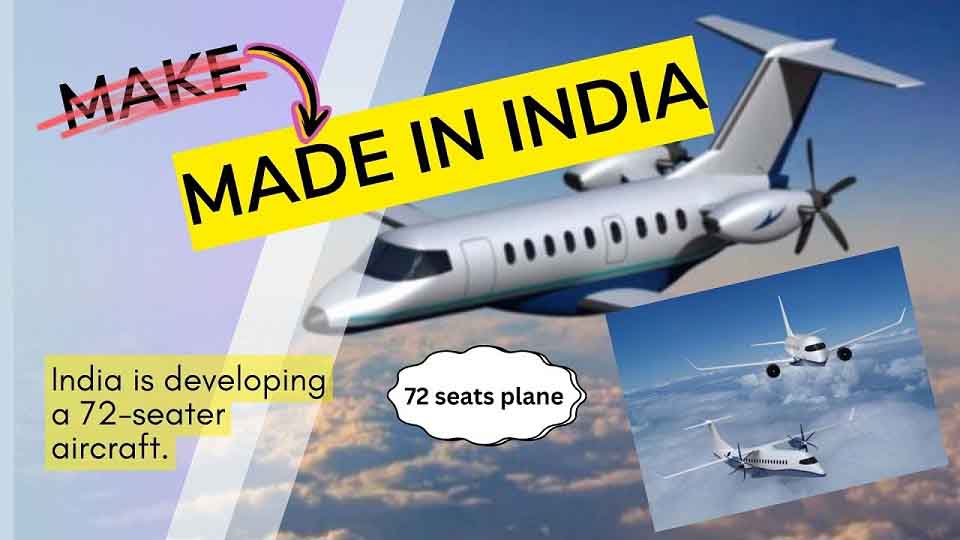
India stands on the cusp of pioneering its aircraft development, a potential reality in the near future. With the Indian aviation market poised to become one of the world’s top five largest markets, there’s a burgeoning demand for carriers like Indigo, Air India, and Akasa. Together, they’ve placed orders for over 1400 aircraft from Boeing and Airbus, marking one of the highest orders in the aviation industry.
‘Made in India’ passenger aircraft.
To transform the dream of a ‘Made in India’ passenger aircraft into reality and propel the local aerospace ecosystem, India requires a comprehensive National Aerospace Policy. Notably, Airbus and Boeing have yet to establish final aircraft assembly lines (FALs) within India, spurred by the significant orders received.
India has exerted considerable pressure to establish assembly lines domestically, mirroring the success of similar initiatives abroad. With its aviation market growing at an unprecedented rate, India boasts the largest order book for new aircraft, estimated at a staggering $70 billion over the next decade. Existing airports bustle with travelers while new ones are either under construction or in the planning phase.
The timeline for India to realize the Prime Minister’s vision of a Made in India commercial aircraft hinges on various factors. Leveraging its prowess in exporting IT services and aerospace technologies, India is poised for the next stage of development.
The success rate of China’s C919 and ARJ21.
In the realm of commercial aerospace manufacturing, Europe and the US have long held the reins, but China has emerged as a formidable contender in recent years. China’s journey began in 2002 with the ARJ21, a regional jet, and later the C919, a larger narrow-body aircraft. While the ARJ21 encountered delays and is seen as a modest achievement, the C919 boasts over one thousand orders, marking a significant success.
Both programs heavily rely on foreign technologies sourced from global original equipment manufacturers (OEMs), underscoring the importance of collaborations and creating an appealing environment for foreign companies to operate within China.
Indian HAL has 80 years of history.
India, too, boasts a rapidly growing aerospace sector that traces its roots back to pre-independence times, predating China’s endeavors by over 60 years. Hindustan Aeronautics Ltd (HAL), initially established as Hindustan Aircraft Ltd in 1940, spearheaded this journey. Given its early establishment, India was poised to become a major player in aerospace manufacturing.
HAL shoulders much of the responsibility for developing aircraft for defense purposes, including the TEJAS, attack and multirole helicopters, trainer aircraft, and notably, the Dornier D228, a passenger version aircraft representing a significant breakthrough for the Indian Aerospace Industry. Demand for helicopters is also on the rise, further showcasing India’s potential in the aerospace domain.
India’s aviation market Demand.
One drawback in the defense sector is the inherent uncertainty surrounding government budgets and delays in allocating funds for helicopter purchases. On the civilian front, aircraft demand remains consistently high, especially when they meet passenger needs and receive regular approvals from authorities.
India’s aviation market is distinct, calling for unique aircraft programs. With a high density of flyers, there’s a prevalent preference for short-haul flights from rural areas to major cities. As the air travel network expands to Tier-2 and Tier-3 cities, the number of operational airports is expected to surge from the current 140 to 230-240.
The demand for smaller aircraft, particularly for serving Tier 1-3 cities, is paramount for airlines. While the Dornier aircraft has been utilized for some routes, its availability limitations and noise levels have raised concerns. Jet planes emerge as preferable options for Indian travelers due to their efficiency and comfort, aligning better with the needs of airlines.
Establishing a sustainable aircraft program requires long-term commitment and substantial risk capital, often necessitating government support akin to what’s observed in developed markets. For instance, COMAC, over its lifetime, received significant state-related support ranging from $49-72 billion, while Airbus, over the years, obtained $22 billion from the EU.
Encouraging private investment is crucial for fostering growth in the aerospace sector and nurturing indigenous aircraft development in India. Such initiatives could significantly bolster the country’s aviation industry and enhance its self-reliance in this critical domain.
Indian Regional Jet (IRJ).
Introducing the Indian Regional Jet (IRJ), a cutting-edge project led by India’s National Aerospace Laboratories (NAL) and set to be manufactured by Hindustan Aeronautics Limited (HAL). This regional airliner aims to redefine air travel with its design, offering a capacity of 80–100 passengers. The base model, known as the RTA-70, will boast 80–90 seats while distinguishing itself with a cost that’s 20 percent lower than its global counterparts.
Development is well underway, with plans for a 90-seater variant expected to take flight by 2026. This next-generation aircraft promises impressive specs, including a range of 1,350 nm (2,500 km), and requiring a take-off and landing field length of 900m (2,950 ft). With dimensions of 28.6m in length and a wingspan of 29.4m, it reaches a service ceiling of 30,000 ft and cruises at 300kt, all while meeting Stage 4 noise criteria.
Saras Aircraft.
Meanwhile, NAL’s innovative spirit extends to the NAL Saras, another project in the works. Already, prototypes like the Mark1 and its successor, the second version dubbed ‘Mark 2,’ are pushing boundaries. The Saras Mark 2 showcases versatility, offering ranges of 600 km with 19 passengers, 1,200 km with 14 passengers, and an impressive 2,000 km with eight passengers. With a top cruise speed exceeding 600 km/h and an endurance of six hours, it’s a game-changer.
Weights
Max. take-off : 7600 kg (16755 lb)
Operating empty wt. : 5100 kg (11244 lb)
Max. fuel weight : 1832 kg (4039 lb)
Max. pay load : 1710 kg (3770 lb)
Power plant
SARAS is powered by two Pratt and Whitney Canada.
PT6A-67A turbo-prop engines (flat rated to 1200 shp)
driving 2.6 m diameter 5 bladed constant speed propellers
at 1700 rpm in a Tractor configuration.
Main dimensions
Span : 18 m (59.05 ft)
Length : 17.3 m (56.8 ft)
Height : 5.5 m (18 ft)
Performance (ISA)
Take-off distance : 820 m (2690 ft)
Landing distance : 665 m (2182 ft)
Max. rate of climb : 10 m/s (1980 ft/min)
Max. range* (19 pax) : 750 km (405 nm)
Max. range* (10 pax) : 2350 km (1270 nm)
Ferry range* : 2400 km (1295 nm)
Max. cruise speed : 485 km/hr (260 Kts)
Endurance : 6 hours . With 45 min reserve
Equipped with propeller engines initially, the Saras is poised for future upgrades to jet engines if project requirements align. NAL’s ambition shines through in its cost-effective approach, targeting ₹50 crore per unit for the Saras Mk2, undercutting the ₹55 crore Dornier 228 with its unpressurized cabin and altitude restrictions. Anticipating government support, NAL aims to secure orders for 50-60 units to ensure manufacturing viability, with an initial order of 15 aircraft from the Indian Air Force potentially expanding to 120–140 units in the coming years.
Aviation
Emirates is hiring pilots with higher salaries across 18 countries
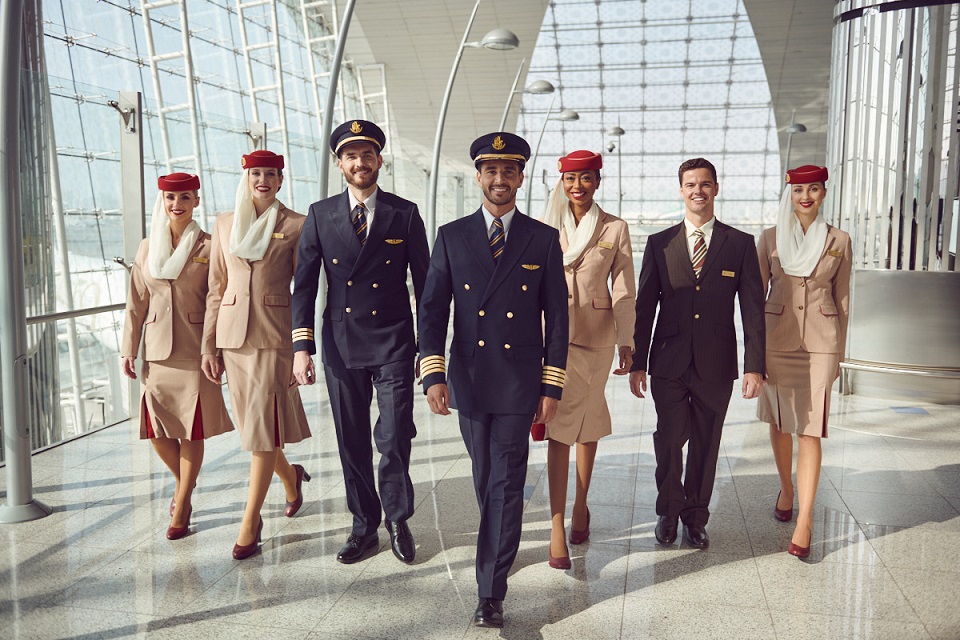
Emirates Airlines, headquartered in Dubai, has unveiled a series of significant alterations to its recruitment strategy, particularly targeting aviators.
Celebrating World Pilots’ Day, the airline is rolling out enticing incentives including augmented salaries and novel roles for prospective pilots. This initiative aims to bolster its esteemed ranks with top-notch talent.
Among the key changes, Emirates is extending a warm welcome to First Officers who lack type ratings, opening doors for those with experience limited to turbo props or jets. These aviators will now have the opportunity to undergo comprehensive training to operate Emirates’ expansive fleet of 144 Boeing aircraft, traversing its vast network spanning over 140 destinations. Additionally, they’ll have the chance to pilot the innovative Boeing 777-Xs slated to join the fleet starting 2025.
Emirates is further enhancing career progression opportunities through its Accelerated Command Programme, previously exclusive to the A380 fleet, now extended to include Boeing 777s. This presents a remarkable avenue for motivated captains flying narrow-body aircraft to swiftly transition to wide-body aircraft within Emirates’ fast-track promotion program.
In another strategic move, the airline is seeking Direct Entry Captains for its eagerly anticipated A350 fleet. With deliveries set to commence mid-year, Emirates is offering enhanced remuneration packages to attract top-tier talent for both the A350s and A380s.
Moreover, Emirates is elevating its recruitment efforts by offering lucrative salary packages to experienced First Officers with over 4,000 flying hours on modern Airbus fly-by-wire or Boeing aircraft. Interested pilots, who would like to learn more about the various flight deck roles, can get more info on entry requirements here.
Pilots joining Emirates can expect a host of perks including competitive tax-free salaries, profit share, spacious accommodations in gated communities, education allowances, comprehensive healthcare coverage, and access to a provident fund. They are also provided with chauffeur-driven transport, laundry services, generous annual leave, and concessional travel benefits for themselves and their families.
As Emirates gears up for substantial growth with the impending arrival of 65 A350s and a mix of 205 777-9s and 777-8s, the airline is intensifying its pilot recruitment efforts. This year, Emirates’ recruitment team will embark on a global roadshow spanning 26 cities across 18 countries.
To checkout the eligibility criteria and apply for pilot roles, click here: https://www.emiratesgroupcareers.com/pilots/
Aerospace
India is set to build a central command for the Air Traffic Control system, called ISHAN

India’s air traffic growth has led to increased responsibilities for air traffic control. The Airports Authority of India (AAI) is considering centralizing air traffic control for aircraft, dividing the country into four regions. The goal is to consolidate India’s segmented airspace into a single entity to improve air traffic management (ATM) efficiency, safety, and smoothness.
Recently, the AAI invited expressions of interest to develop a detailed project report for the Indian Single Sky Harmonized Air Traffic Management (ISHAN) initiative in Nagpur. Under this plan, air traffic controllers in Nagpur would handle domestic flights flying above 25,000 feet, eliminating the need for coordination among controllers in different regions.
For domestic regional flights operating above 25,000 feet, control would shift to the central command in Nagpur. This consolidation aims to enhance airline operations, increase flight handling capacity, and reduce congestion and flight times for passengers.
Currently, the AAI provides ATM services over Indian airspace and adjoining oceanic areas, covering over 2.8 million square nautical miles. This airspace is divided into four flight information regions (FIRs) in Delhi, Mumbai, Kolkata, and Chennai, along with a sub-FIR in Guwahati.
FIRs are responsible for providing air traffic services, including weather information, visibility, and search and rescue assistance. The proposed unification under the ISHAN initiative aligns with the projected growth of the aviation industry, which anticipates a doubling of domestic passenger traffic by 2030.

